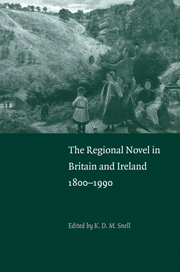Book contents
- Frontmatter
- Contents
- Preface and acknowledgements
- 1 The regional novel: themes for interdisciplinary research
- 2 Regionalism and nationalism: Maria Edgeworth, Walter Scott and the definition of Britishness
- 3 The deep romance of Manchester: Gaskell's ‘Mary Barton’
- 4 Geographies of Hardy's Wessex
- 5 Gender and Cornwall: Charles Kingsley to Daphne du Maurier
- 6 James Joyce and mythic realism
- 7 Cookson, Chaplin and Common: three northern writers in 1951
- 8 Emyr Humphreys: regional novelist?
- 9 Scotland and the regional novel
- 10 Mapping the modern city: Alan Sillitoe's Nottingham novels
- Index
9 - Scotland and the regional novel
Published online by Cambridge University Press: 18 December 2009
- Frontmatter
- Contents
- Preface and acknowledgements
- 1 The regional novel: themes for interdisciplinary research
- 2 Regionalism and nationalism: Maria Edgeworth, Walter Scott and the definition of Britishness
- 3 The deep romance of Manchester: Gaskell's ‘Mary Barton’
- 4 Geographies of Hardy's Wessex
- 5 Gender and Cornwall: Charles Kingsley to Daphne du Maurier
- 6 James Joyce and mythic realism
- 7 Cookson, Chaplin and Common: three northern writers in 1951
- 8 Emyr Humphreys: regional novelist?
- 9 Scotland and the regional novel
- 10 Mapping the modern city: Alan Sillitoe's Nottingham novels
- Index
Summary
Regionalism is an almost all-embracing category in relation to the Scottish novel: simply by virtue of being Scottish, almost all Scottish novels will be identified as regional within the traditions of the English novel, rather than representing an alternative national tradition. And because ‘Scottishness’ has been identified primarily with lower-class or working-class Scots (middle-class Scots being those who have been ‘anglified’), Scottish novels will almost inevitably fulfill the key features of the regional novel as identified by Keith Snell in his Introduction to this volume – locale, dialect and a primarily lower class community. There is, however, an equally insistent regionalism within the borders of Scotland itself. Scottish novelists may construct their narratives as paradigms of a national consciousness, but they generally do so by locating their narrative within strictly demarcated regional boundaries, and as a consequence almost all the major Scottish novelists are identified with specific areas of Scotland – whether it is John Galt and George Douglas Brown with Ayrshire, Lewis Grassic Gibbon and Nan Shepherd with the Mearns, Neil Gunn with Sutherland and Caithness, George Mackay Brown with Orkney, or James Kelman with Glasgow.
- Type
- Chapter
- Information
- The Regional Novel in Britain and Ireland1800–1990, pp. 221 - 256Publisher: Cambridge University PressPrint publication year: 1998
- 1
- Cited by



